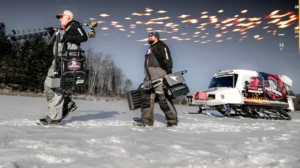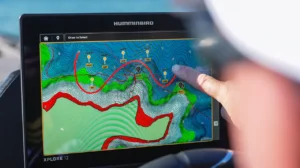At some point in your life, you’ve probably witnessed schooling largemouth, smallmouth, or spotted bass out in the abyss of a lake. Every year, populations of bass make their way out to deep, open water in search of one thing – bait. In this video, Bassmaster Elite Series Pro Chris Zaldain shows how to stay on schooling fish using forward-facing sonar.
FEATURED GEAR (retail links)
- ROD – 13 Fishing Envy Black III Casting Rod, 7’1″ Medium, buy at Tackle Warehouse
- REEL – 13 Fishing Concept A2 Casting Reel, 8.3:1, buy at Tackle Warehouse
- FISH FINDER – Humminbird SOLIX 12 CHIRP MEGA SI+ G3, buy at Tackle Warehouse
- 360 SONAR – Humminbird MEGA 360 Imaging, buy at Tackle Warehouse
- FORWARD-FACING SONAR – Humminbird MEGA Live Imaging, buy at Tackle Warehouse
- MAPPING – Humminbird LakeMaster With VX Technology, Midsouth States V1, buy at Tackle Warehouse
- TROLLING MOTOR – Minn Kota Ultrex 112lb-36V Trolling Motor, buy at Tackle Warehouse
- BASS BOAT – Skeeter FXR20, check out at Skeeterboats.com
Schooling bass can be very easy to track down when they are blowing bait out of the water, but how about when they are subsurface? Zaldain explains that there is really only one way to keep up with these fish. Forward-facing sonar, like Humminbird’s MEGA Live, allow you to constantly stay on fish that are simply chasing down bait. As shown in the video, these bass have no problem swimming hundreds of yards to track down a tiny ball of shad. Although staying on top of them is key, there are several other benefits to watching them on forward-facing sonar.
Zaldain admits that he has learned a substantial amount of knowledge about schooling bass just from watching their behavior on MEGA Live. “Until the bait comes, it’s almost pointless to make a cast,” states Zaldain. But once the bait shows up, it’s game on. Bass will ambush bait balls towards the surface until there is nowhere else to hide. All you have to do is get your lure in on the feeding frenzy, and it’s usually a done deal. The biggest thing that Zaldain harps, though, is that you must allow yourself the opportunity to be within casting distance of the schools of feeding bass. The only way to do that; follow them around, examine their behavior, and be ready to cast when all hell breaks loose.












